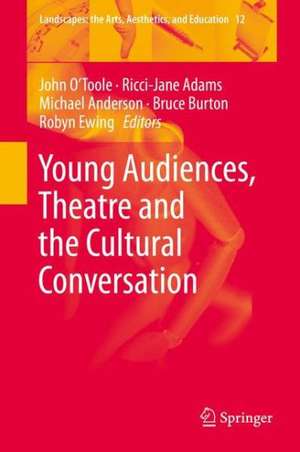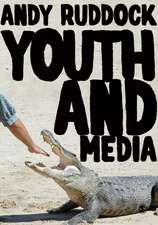Young Audiences, Theatre and the Cultural Conversation: Landscapes: the Arts, Aesthetics, and Education, cartea 12
Editat de John O'Toole, Ricci-Jane Adams, Michael Anderson, Bruce Burton, Robyn Ewingen Limba Engleză Hardback – 8 ian 2014
| Toate formatele și edițiile | Preț | Express |
|---|---|---|
| Paperback (1) | 636.63 lei 6-8 săpt. | |
| SPRINGER NETHERLANDS – 17 sep 2016 | 636.63 lei 6-8 săpt. | |
| Hardback (1) | 642.83 lei 6-8 săpt. | |
| SPRINGER NETHERLANDS – 8 ian 2014 | 642.83 lei 6-8 săpt. |
Din seria Landscapes: the Arts, Aesthetics, and Education
- 20%
 Preț: 690.43 lei
Preț: 690.43 lei - 18%
 Preț: 894.34 lei
Preț: 894.34 lei - 18%
 Preț: 892.11 lei
Preț: 892.11 lei - 18%
 Preț: 728.60 lei
Preț: 728.60 lei - 22%
 Preț: 640.83 lei
Preț: 640.83 lei - 15%
 Preț: 639.73 lei
Preț: 639.73 lei - 18%
 Preț: 948.79 lei
Preț: 948.79 lei - 20%
 Preț: 565.08 lei
Preț: 565.08 lei - 15%
 Preț: 644.95 lei
Preț: 644.95 lei - 24%
 Preț: 1158.48 lei
Preț: 1158.48 lei - 15%
 Preț: 645.28 lei
Preț: 645.28 lei - 18%
 Preț: 788.09 lei
Preț: 788.09 lei - 15%
 Preț: 704.50 lei
Preț: 704.50 lei - 15%
 Preț: 646.30 lei
Preț: 646.30 lei - 15%
 Preț: 647.73 lei
Preț: 647.73 lei - 18%
 Preț: 998.66 lei
Preț: 998.66 lei - 18%
 Preț: 733.96 lei
Preț: 733.96 lei - 18%
 Preț: 784.92 lei
Preț: 784.92 lei - 18%
 Preț: 891.48 lei
Preț: 891.48 lei - 15%
 Preț: 701.40 lei
Preț: 701.40 lei - 18%
 Preț: 786.66 lei
Preț: 786.66 lei - 18%
 Preț: 885.49 lei
Preț: 885.49 lei -
 Preț: 384.48 lei
Preț: 384.48 lei - 18%
 Preț: 898.43 lei
Preț: 898.43 lei - 15%
 Preț: 641.71 lei
Preț: 641.71 lei -
 Preț: 350.89 lei
Preț: 350.89 lei - 18%
 Preț: 941.68 lei
Preț: 941.68 lei - 18%
 Preț: 779.39 lei
Preț: 779.39 lei - 18%
 Preț: 786.18 lei
Preț: 786.18 lei
Preț: 642.83 lei
Preț vechi: 756.27 lei
-15% Nou
Puncte Express: 964
Preț estimativ în valută:
123.00€ • 128.77$ • 101.78£
123.00€ • 128.77$ • 101.78£
Carte tipărită la comandă
Livrare economică 07-21 aprilie
Preluare comenzi: 021 569.72.76
Specificații
ISBN-13: 9789400776081
ISBN-10: 940077608X
Pagini: 220
Ilustrații: XVII, 201 p. 48 illus.
Dimensiuni: 155 x 235 x 20 mm
Greutate: 0.49 kg
Ediția:2014
Editura: SPRINGER NETHERLANDS
Colecția Springer
Seria Landscapes: the Arts, Aesthetics, and Education
Locul publicării:Dordrecht, Netherlands
ISBN-10: 940077608X
Pagini: 220
Ilustrații: XVII, 201 p. 48 illus.
Dimensiuni: 155 x 235 x 20 mm
Greutate: 0.49 kg
Ediția:2014
Editura: SPRINGER NETHERLANDS
Colecția Springer
Seria Landscapes: the Arts, Aesthetics, and Education
Locul publicării:Dordrecht, Netherlands
Public țintă
ResearchCuprins
Foreword.- Acknowledgments.- Part I TheatreSpace Project Partners and Case Studies.- Chapter 1: Introduction.- Chapter 2: The Project, its Partners and its Purposes.- Chapter 3: Access and the Practicalities of Attendance.- Chapter 4: The Context of the Performance Event.- Chapter 5: The Education Landscape.- Chapter 6: Young Audiences from the Educators' Perspective.- Chapter 7: The Industry Partners’ Perceptions.- Chapter 8: Engagement and Liveness.- Chapter 9: Building Theatre Confidence.- Chapter 10: Theatre Literacy.- Chapter 11: ‘It’s Real’ - Genre and Performance Style.- Chapter 12: Conclusion – a Continuum for Planning.
Textul de pe ultima copertă
This volume offers rare insights into the connection between young audiences and the performing arts. Based on studies of adolescent and post-adolescent audiences, ages 14 to 25, the book examines to what extent they are part of our society’s cultural conversation. It studies how these young people read and understand theatrical performance. It looks at what the educational components in their theatre literacy are, and what they make of the whole social event of theatre. It studies their views on the relationship between what they themselves decide and what others decide for them. The book uses qualitative and quantitative data collected in a six-year study carried out in the three largest Australian States, thirteen major performing arts companies, including the Sydney Opera House, three state theatre companies and three funding organisations. The book’s perspectives are derived from world-wide literature and company practices and its significance and ramifications are international.
The book is written to be engaging and accessible to theatre professionals and lay readers interested in theatre, as well as scholars and researchers.
The book is written to be engaging and accessible to theatre professionals and lay readers interested in theatre, as well as scholars and researchers.
Caracteristici
Offers rare insights on how adolescent and post-adolescent young audiences experience and appreciate the theatre Results from a six year study involving three Australian states and thirteen major performing arts companies A thorough investigation into the extent to which young audiences are part of our society's cultural conversation













